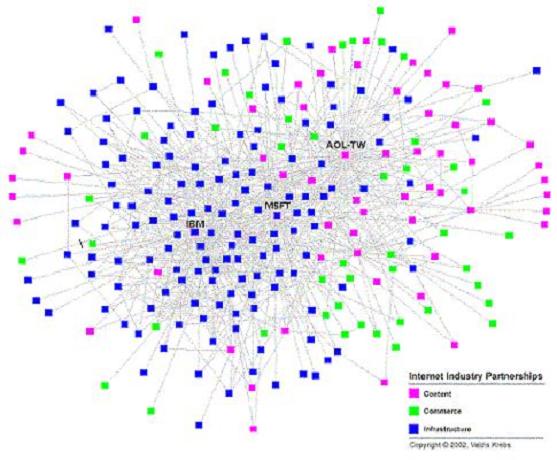What is Network Mapping?
Network mapping is all about how a "picture is worth a thousand words." Network mapping uses special software to map out the relationships between ideas, concepts, people, or transactions.
It helps you see things you might not otherwise see (or see as clearly) except for being presented graphically. For example, this network map demonstrates key players in the Internet industry:

Other uses of network maps include identifying terrorist networks, tracing the spread of contagious diseases, and identifying thought leaders in a company for purposes of integrating acquisitions and mergers.
Or, as colleague Valdis Krebs has shown, network mapping can be used to illustrate political leanings through examining book-buying data from Amazon.com and barnesandnoble.com (see New York Times article).
Selling to the Small Business Market
I'm intrigued by the thought of using network maps to identify and "see" the buying behaviors by small businesses. And figure out how to cost effectively sell to the small business market.
The size of the small business market, both in the U.S. and worldwide, is huge. And due to its size, it is attractive. But it is also difficult to sell into this market cost-effectively. Companies often can't afford the marketing and sales efforts to reach such a fragmented market.
Many vendors resort to selling through channel partners who have existing relationships with small businesses. They do, that is, if they can identify the right channel partners. In some industries, it is not readily apparent who the right channel partners are, i.e., which entities have contact points with the intended small business targets.
This is where network maps could be an important analytic tool.
Let me give you an example. Kirsten over at re:invention recently wrote that eBay's deal with Monster.com was not likely to work, because small businesses simply didn't go through Monster to hire personnel.
In that instance, eBay (an extraordinarily well-run company, but not always perfect) had made a choice of a partner that is not likely to be able to deliver the small business market.
A network map might have been a useful tool. By mapping out the job recruitment players in major metropolitan markets, eBay might have identified better channel partners. Or determined that a partner approach just would not work.
I'd be interested to hear from you, readers, about using network mapping for selling to the small business market. Is this a promising technique? Or are there other, better answers, and if so, what are they? Or is selling to the small business market simply a problem without easy solutions? Email me at anita-at-anitacampbell.com with your comments. I will collect them in a subsequent post.
No comments:
Post a Comment